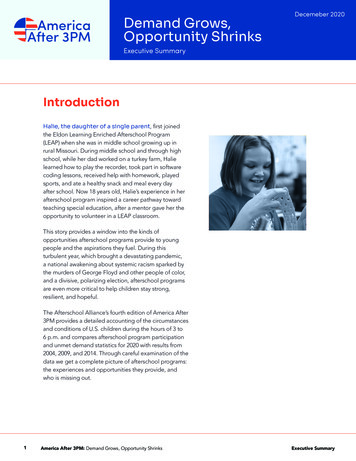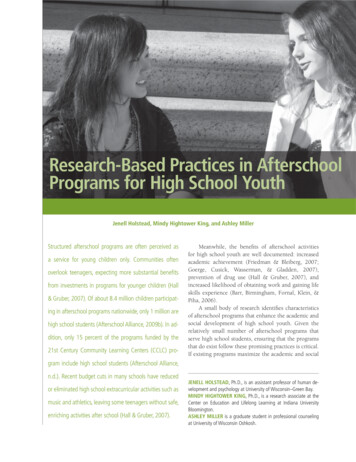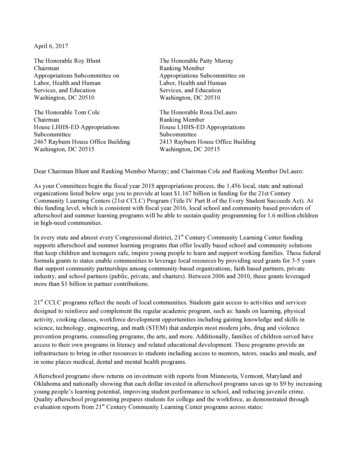
Transcription
the effect of afterschoolprogram participationon englishlanguage acquisitionby Rebecca London, Oded Gurantz, and Jon NormanIn the past quarter century, the nation’s K–12 publicschools have experienced a large influx of students whospeak languages other than English. In the 2008–09school year, California public schools served 1.5 millionchildren (24 percent of the student population) whoseprimary language was not English (California Department of Education, 2010). This percentage represents asubstantial increase from 25 years earlier, when just 8percent of California’s public school students were English learners (Williams et al., 2007).Research has shown that many factors affect howEnglish learner (EL) students acquire English languageskills, including their preparation before entering U.S.schools, their out-of-school environments, and schools’educational practices (Genesee, Lindholm-Leary, Saunders,& Christian, 2006; Ready & Tindal, 2006; Saunders &ReBeCCA LONDON is senior researcher at the John W. GardnerCenter for Youth and Their Communities at Stanford University. Herresearch concentrates on disadvantaged youth and families, withan emphasis on the role of community interventions in providingopportunities for positive youth development. Her recent studiesinclude the effect of afterschool programs on physical fitness, thelink between physical fitness and academic achievement, and factorsaffecting students’ high-school-to-college trajectories. She is a fellowat the National Poverty Center at the University of Michigan.ODeD GURANTz is the senior policy analyst for the Youth DataArchive initiative at the John W. Gardner Center for Youth and TheirCommunities. His recent work uses linked longitudinal data to explore student pathways through the K–16 system, with a focus onthe transition from secondary to postsecondary education. Odedholds a master’s degree in applied economics and finance from theUniversity of California, Santa Cruz, and a bachelor’s in mathematicsfrom the University of California, Berkeley.JON R. NORMAN is assistant professor in the department of sociology and the graduate program in public policy and urban affairsat Loyola University Chicago. His research centers on urban socialand economic transformation. His recent work includes examinationof family and gender norms in housing policy, analysis of economicinequality in small metro areas, and exploration of the role of citiesversus suburbs in metro area well-being. Jon is currently completing a book manuscript assessing social, demographic, and economicchanges in smaller U.S. cities.
of non-academic settings in helping EL students learnO’Brien, 2006; Valdés, 1998). An in-depth ethnographicEnglish. In this article, we use an innovative data source—study by Valdés (1998) identified the importance of outthe Youth Data Archive—to follow elementary and midof-school social settings, indicating that they heavily afdle school students from a singlefect EL students’ in-school perforschool district over four academicmance. A review of the limitedThe literatures on bothyears to discern any links betweenliterature on out-of-school settingsand oral English language develop- afterschool programming their afterschool program participation and English language development also supports this findingand English acquisitionment. We found that students at(Saunders & O’Brien, 2006).point to the potentialtending the program had greaterHigh-quality afterschool proimportanceofrates of gain in English developgrams offer many benefits, includingment, but they did not necessarilyacademic achievement, but researchnon-academic settingsachieve proficiency gains or redesighas not focused specifically on thein helping EL studentsnation as “fluent English proficient”effects of afterschool programs onlearnEnglish.sooner than non-participating stuEnglish language development. In adents. Our results point to the needmeta-analysis of 35 studies, Lauerfor increased examination of the link between in-schooland colleagues (2006) found that afterschool programand out-of-school activities in relation to English lanming had positive effects on math and reading outcomes,guage acquisition.especially for low-income at-risk students. In addition,research has shown that young people who participatedThe Community and the Programin afterschool programs attended school more regularlyThe setting for this work is Redwood City and the neighthan did non-participants (Espino, Fabiano, & Pearson,boring unincorporated area of North Fair Oaks, located2004; Fabiano, Pearson, Reisner, & Williams, 2006;about 25 miles south of San Francisco in San MateoHuang, Kim, Marshall, & Pérez, 2005; Welsh, Russell,County, California. The Redwood City School DistrictWilliams, Reisner, & White, 2002) and showed improvecomprises 17 schools serving about 9,000 students inments in their work habits (Vandell, Reisner, & Pierce,grades K–8.2007). Some evidence supports a “dosage effect”: studentsThe afterschool program is the Boys & Girls Club ofwho attended programs more frequently experiencedthe Peninsula (BGCP), which has several centers acrossstronger academic gains (McComb & Scott-Little, 2003).San Mateo County. Nearly all (97 percent) of the RedwoodThis finding is difficult to replicate because many afterCity students who attend a Boys & Girls Club go to justschool programs do not keep the detailed attendance reone clubhouse, which is located on the grounds of a K–8cords needed to examine dosage effects.school in the district. This site serves primarily as anTogether, these studies illustrate the benefits of afterafterschool program, though the club is also open forschool programs on students’ academic performance, paractivities on weekends and hosts organizations during theticularly for disadvantaged youth. However, the majority ofschool day, including a small alternative high school.research on afterschool program participation focuses onProgram activities start when school is dismissed.Anglo-American and African-American youth. Research hasThe Boys & Girls Club has partnerships with severalnot fully examined the experiences of Latino youth, whoother schools to have staff walk students to the program.may face different academic and social challenges. LatinoStudents begin with homework help in computer classyouth in afterschool programs are more likely to be EL sturooms or working with staff and volunteers. They maydents, to be immigrants to the U.S., and to come fromcomplete extra worksheets, engage in independent readlower-income households (KewelRamani, Gilbertson, Fox,ing, or occasionally work on art projects. At the end of& Povasnik, 2007). Researchers have examined children ofthe homework hour, students move on to activities formigrant Latino workers (Riggs & Greenberg, 2004) andwhich they or their parents have signed up, such as openrural Latino children (Riggs, 2006) who attend afterschoolgym time, arts and crafts, or enrichment programs.programs, but few large-scale studies have examined LatinoStructured programming ends about 5:30 p.m., whenstudents’ participation in afterschool programs or the effectsstudents congregate in a game room stocked with foosof participation on English language acquisition.ball, pool, and board games to wait for their parents toThe literatures on both afterschool programmingpick them up.and English acquisition point to the potential importanceLondon, Oded, & Norman the effect of afterschool program participation on english language acquisition23
Data and MethodsData for this study come from the Youth Data Archive(YDA), which consists of individual-level data for youngpeople in several San Francisco Bay Area communities.The data are supplied by public and private agencies including school districts, city and county agencies, andlocal or regional nonprofit youth-serving agencies. Thedata are linked individually across sources and over timeto create a longitudinal record of each youth’s schooling,program participation, and services received.Using identifiers such as name, address, birth date,grade, and school, we linked school records individuallyto participation data from the Boys & Girls Club.District data contain detailed information on students’demographic and socioeconomic characteristics as wellas academic performance. Program data include days ofparticipation collected by each program site.We examined the effects of students’ program participation on their English language development in thesubsequent year. Since such an analysis relies on consecutive years of data, we included only students whowere enrolled in the district at least two consecutiveyears, concentrating on students who attended the program up to eighth grade. Using data from four academicyears, we identified a total of 1,941 instances where astudent was enrolled in the district in consecutive yearsand participated in the program one or both years.Program participants attended an average of 48.5 daysper school year, mainly at the Redwood City club.English Language MilestonesAnalyses first considered program participation and thenexamined the effects of participation and its extent (“dosage”) on students’ subsequent English language gains, asmeasured by the California English Language DevelopmentTest (CELDT). The CELDT—which is administered in thefall of each academic year—assesses English proficiencyin four areas: listening, speaking, reading, and writing. Ineach area, students receive a proficiency level of Beginner,Early Intermediate, Intermediate, Early Advanced, orAdvanced. Their overall proficiency level is derived byequally weighting the four subtests. K–1 students are tested only on listening and speaking. Students are considered “English proficient” when they earn an overall scoreof Early Advanced or higher, with a score of Intermediateor higher on each subtest.Students with a primary language other than Englishand no previous history of English proficiency testingmust take the CELDT within 30 days of entry into aCalifornia school district. Students who score at the24 Afterschool Matters “English proficient” level on entry are classified as InitiallyFluent English Proficient (IFEP); those not meeting thisrequirement are designated as English learners and mustretake the CELDT annually until they meet the requirements to become Redesignated Fluent English Proficient(RFEP). Being “English proficient” is not the same asmeeting the RFEP requirements; RFEP requires Englishproficiency as well as demonstrated language ability onstandardized tests and approval by teachers and parents.Students who have English as their primary language arereferred to as English only (EO).Our analysis considered three language milestones.Two of these milestones, set out in Title III of No ChildLeft Behind, are the Annual Measurable AchievementObjectives (AMAO) that school districts must meet. Thethird is redesignation. AMAO 1 measures the annual progress of EL students,requiring that students whose overall scores areBeginning, Early Intermediate, or Intermediate improve one level by the following year. Those who scoreEarly Advanced or Advanced must attain or maintain“English proficient” status. AMAO 2 measures the percentage of EL students whohave achieved “English proficient” status among thosewho could reasonably be expected to have reached thisstatus, as defined by the California Department ofEducation. Redesignated Fluent English Proficient (RFEP) students meet all three of the following criteria: attaining“English proficiency” on the CELDT; achieving a minimum score on the California English Language ArtsStandards Test, which is administered in English; andbeing evaluated as ready for reclassification by bothteacher and parents.MethodologyWe first used logistic regressions to model the determinantsof program participation among district students, controlling for a host of demographic and school-related factors.We then examined the effects of program participati of the test. Attending for 1–89 or 90 orwith slightly larger but not quite significant effect—an inmore days was positively associated with improvements increased odds of 1.35. The second and third columns ofthe writing portion. However, none of these odds ratiosTable 4 explore the determinants of reaching AMAO 2 andreach statistical significance, so they cannot be distinRFEP. Whereas every EL student is subject to AMAO 1,guished, statistically, from a zero effect.which measures annual progress on the CELDT, AMAO 2and RFEP are based on the subset of EL students who arePolicy Implicationsreasonably expected to reach English fluency. For neitherUsing data from one elementary school district and a largeAMAO 2 nor RFEP did we find that attending the programafterschool program provider in California’s San Franciscohad a measurable effect on reaching the milestone. StudentsBay Area, we analyzed the effects of afterschool programwere redesignated based on several factors, including thoseparticipation on English language development of EL stuthat factor into determining AMAO 1 and AMAO 2, but anydents in grades 1–7. ConsistentEnglish gains students made at thewith the literature on the effects ofBoys & Girls Club did not appear toAlthough afterschoolafterschool programming on acabe assisting them in being redesigprogramming has beendemic outcomes, we found somenated more quickly than their peerslinked to a host of positive evidence that participation in thewho did not attend the program.program’s various activities, andThrough the fieldwork we conacademic outcomes,possibly at higher levels of engageducted at two program sites, weparticularly forment, was associated with one mealearned that the afterschool programdisadvantaged youth, our sure of improvement in Englishming was not specifically focused onresults establish one of the language development as measuredEnglish language attainment. Whythen would we see an improvedby the test used statewide to assessfirst links betweenchance of attaining AMAO 1 amongEL students. We found this resultafterschool participationstudents who participated? We prowe examined improvementsand language development whenpose two possible explanations. First,in English development overall, butamong EL students.it may be that youth who attendedprogram participation did not apthe club gained skills in specific aspear to be affecting students’pects of language, but not in others. For instance, althoughEnglish proficiency or their redesignation to Fluentprogram staff members were all bilingual, adult volunteersEnglish Proficient. Some evidence suggests that afterwere mostly English speaking. Students who attended theschool participants may have made more gains in the lisclub were put in situations that required them to speaktening and speaking portions of the test than in readingEnglish and follow instructions in English. If this exposureand writing, but these results are not conclusive.helped them to understand or speak English better, theyOur work suggests several policy-related conclumay have improved more in the speaking and listening porsions. First, although afterschool programming hastions of the CELDT but perhaps less in the reading and writbeen linked to a host of positive academic outcomes,ing portions. Second, selection biases associated with whoparticularly for disadvantaged youth, our results estabattended the program and who attended more regularlylish one of the first links between afterschool participamay be driving the results. We controlled for factors such astion and language development among EL students. Infamily economic and educational background, but we werestates with large immigrant populations like California,unable to observe important factors such as student motivawhere one quarter of the public school population istion or family drive for educational success.designated as not proficient in English (Williams et al.,28 Afterschool Matters Spring 2011
2007), understanding the processes of language development both in and out of school is critical in helpingstudents progress. The geographic context of this workoffers an important frame. Students in Redwood City,particularly at the school in which the afterschool site islocated, live in communities that are heavily concentrated with Latino immigrants. Students’ social networks are likely to encourage the use of their primarylanguage; the afterschool program may be one of thefew places outside of school where students can try outtheir English listening and speaking skills.Finally, the value of linking disparate sources of datain ways that allow for new cross-agency analyses hasmany policy implications. The Youth Data Archive modelof tracking individual young people across the variousinstitutions that serve them throughout the communitycan be applied to a variety of policy areas to answer ahost of questions about how we are and should be serving youth both in and out of school. Cross-agency datasharing with the goal of supporting youth in communities offers tremendous potential in documenting themechanisms for creating positive youth outcomes.KewelRamani, A., Gilbertson, L., Fox, M. A., & Povasnik,S. (2007). Status and trends in the education of racial andethnic minorities. Washington, DC: National Center forEducation Statistics, U.S. Department of Education.ReferencesRiggs, N. R., & Greenberg, M. T. (2004). Moderators inthe academic development of migrant Latino childrenattending after-school programs. Applied DevelopmentalPsychology, 25, 349–367.California Department of Education. (2010). DataQuest.Available from http://www.cde.ca.gov/ds/Espino, J., Fabiano, L., & Pearson, L. M. (2004). Citizenschools: Evidence from two stude
The Redwood City School District comprises 17 schools serving about 9,000 students in grades K-8. The afterschool program is the Boys & Girls Club of the Peninsula (BGCP), which has several centers across . . school day, including a small alternative high school. Program activities start when school is dismissed.










